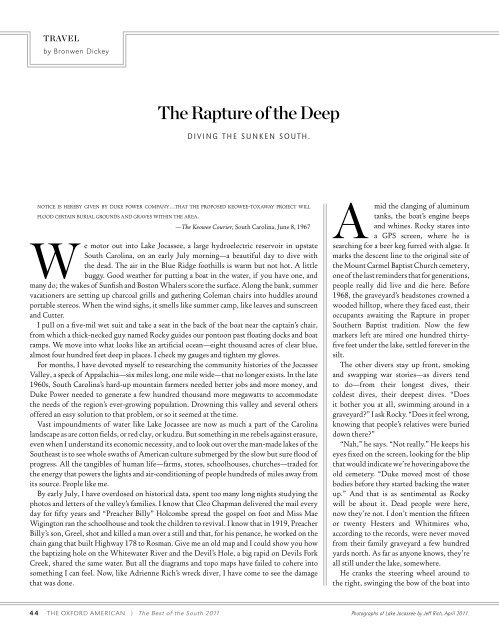The Rapture of the Deep - Bronwen Dickey
The Rapture of the Deep - Bronwen Dickey
The Rapture of the Deep - Bronwen Dickey
You also want an ePaper? Increase the reach of your titles
YUMPU automatically turns print PDFs into web optimized ePapers that Google loves.
TRAVEL<br />
by <strong>Bronwen</strong> <strong>Dickey</strong><br />
44 THE OXFORD AMERICAN } <strong>The</strong> Best <strong>of</strong> <strong>the</strong> South 2011<br />
<strong>The</strong> <strong>Rapture</strong> <strong>of</strong> <strong>the</strong> <strong>Deep</strong><br />
diving <strong>the</strong> sunken south.<br />
NOTICE IS HEREBY GIVEN BY DUKE POWER COMPANY…THAT THE PROPOSED KEOWEE-TOXAWAY PROJECT WILL<br />
FLOOD CERTAIN BURIAL GROUNDS AND GRAVES WITHIN THE AREA.<br />
—<strong>The</strong> Keowee Courier, South Carolina, June 8, 1967<br />
We motor out into Lake Jocassee, a large hydroelectric reservoir in upstate<br />
South Carolina, on an early July morning—a beautiful day to dive with<br />
<strong>the</strong> dead. <strong>The</strong> air in <strong>the</strong> Blue Ridge foothills is warm but not hot. A little<br />
buggy. Good wea<strong>the</strong>r for putting a boat in <strong>the</strong> water, if you have one, and<br />
many do; <strong>the</strong> wakes <strong>of</strong> Sunfish and Boston Whalers score <strong>the</strong> surface. Along <strong>the</strong> bank, summer<br />
vacationers are setting up charcoal grills and ga<strong>the</strong>ring Coleman chairs into huddles around<br />
portable stereos. When <strong>the</strong> wind sighs, it smells like summer camp, like leaves and sunscreen<br />
and Cutter.<br />
I pull on a five-mil wet suit and take a seat in <strong>the</strong> back <strong>of</strong> <strong>the</strong> boat near <strong>the</strong> captain’s chair,<br />
from which a thick-necked guy named Rocky guides our pontoon past floating docks and boat<br />
ramps. We move into what looks like an artificial ocean—eight thousand acres <strong>of</strong> clear blue,<br />
almost four hundred feet deep in places. I check my gauges and tighten my gloves.<br />
For months, I have devoted myself to researching <strong>the</strong> community histories <strong>of</strong> <strong>the</strong> Jocassee<br />
Valley, a speck <strong>of</strong> Appalachia—six miles long, one mile wide—that no longer exists. In <strong>the</strong> late<br />
1960s, South Carolina’s hard-up mountain farmers needed better jobs and more money, and<br />
Duke Power needed to generate a few hundred thousand more megawatts to accommodate<br />
<strong>the</strong> needs <strong>of</strong> <strong>the</strong> region’s ever-growing population. Drowning this valley and several o<strong>the</strong>rs<br />
<strong>of</strong>fered an easy solution to that problem, or so it seemed at <strong>the</strong> time.<br />
Vast impoundments <strong>of</strong> water like Lake Jocassee are now as much a part <strong>of</strong> <strong>the</strong> Carolina<br />
landscape as are cotton fields, or red clay, or kudzu. But something in me rebels against erasure,<br />
even when I understand its economic necessity, and to look out over <strong>the</strong> man-made lakes <strong>of</strong> <strong>the</strong><br />
Sou<strong>the</strong>ast is to see whole swaths <strong>of</strong> American culture submerged by <strong>the</strong> slow but sure flood <strong>of</strong><br />
progress. All <strong>the</strong> tangibles <strong>of</strong> human life—farms, stores, schoolhouses, churches—traded for<br />
<strong>the</strong> energy that powers <strong>the</strong> lights and air-conditioning <strong>of</strong> people hundreds <strong>of</strong> miles away from<br />
its source. People like me.<br />
By early July, I have overdosed on historical data, spent too many long nights studying <strong>the</strong><br />
photos and letters <strong>of</strong> <strong>the</strong> valley’s families. I know that Cleo Chapman delivered <strong>the</strong> mail every<br />
day for fifty years and “Preacher Billy” Holcombe spread <strong>the</strong> gospel on foot and Miss Mae<br />
Wigington ran <strong>the</strong> schoolhouse and took <strong>the</strong> children to revival. I know that in 1919, Preacher<br />
Billy’s son, Greel, shot and killed a man over a still and that, for his penance, he worked on <strong>the</strong><br />
chain gang that built Highway 178 to Rosman. Give me an old map and I could show you how<br />
<strong>the</strong> baptizing hole on <strong>the</strong> Whitewater River and <strong>the</strong> Devil’s Hole, a big rapid on Devils Fork<br />
Creek, shared <strong>the</strong> same water. But all <strong>the</strong> diagrams and topo maps have failed to cohere into<br />
something I can feel. Now, like Adrienne Rich’s wreck diver, I have come to see <strong>the</strong> damage<br />
that was done.<br />
A<br />
mid <strong>the</strong> clanging <strong>of</strong> aluminum<br />
tanks, <strong>the</strong> boat’s engine beeps<br />
and whines. Rocky stares into<br />
a GPS screen, where he is<br />
searching for a beer keg furred with algae. It<br />
marks <strong>the</strong> descent line to <strong>the</strong> original site <strong>of</strong><br />
<strong>the</strong> Mount Carmel Baptist Church cemetery,<br />
one <strong>of</strong> <strong>the</strong> last reminders that for generations,<br />
people really did live and die here. Before<br />
1968, <strong>the</strong> graveyard’s headstones crowned a<br />
wooded hilltop, where <strong>the</strong>y faced east, <strong>the</strong>ir<br />
occupants awaiting <strong>the</strong> <strong>Rapture</strong> in proper<br />
Sou<strong>the</strong>rn Baptist tradition. Now <strong>the</strong> few<br />
markers left are mired one hundred thirtyfive<br />
feet under <strong>the</strong> lake, settled forever in <strong>the</strong><br />
silt.<br />
<strong>The</strong> o<strong>the</strong>r divers stay up front, smoking<br />
and swapping war stories—as divers tend<br />
to do—from <strong>the</strong>ir longest dives, <strong>the</strong>ir<br />
coldest dives, <strong>the</strong>ir deepest dives. “Does<br />
it bo<strong>the</strong>r you at all, swimming around in a<br />
graveyard?” I ask Rocky. “Does it feel wrong,<br />
knowing that people’s relatives were buried<br />
down <strong>the</strong>re?”<br />
“Nah,” he says. “Not really.” He keeps his<br />
eyes fixed on <strong>the</strong> screen, looking for <strong>the</strong> blip<br />
that would indicate we’re hovering above <strong>the</strong><br />
old cemetery. “Duke moved most <strong>of</strong> those<br />
bodies before <strong>the</strong>y started backing <strong>the</strong> water<br />
up.” And that is as sentimental as Rocky<br />
will be about it. Dead people were here,<br />
now <strong>the</strong>y’re not. I don’t mention <strong>the</strong> fifteen<br />
or twenty Hesters and Whitmires who,<br />
according to <strong>the</strong> records, were never moved<br />
from <strong>the</strong>ir family graveyard a few hundred<br />
yards north. As far as anyone knows, <strong>the</strong>y’re<br />
all still under <strong>the</strong> lake, somewhere.<br />
He cranks <strong>the</strong> steering wheel around to<br />
<strong>the</strong> right, swinging <strong>the</strong> bow <strong>of</strong> <strong>the</strong> boat into<br />
Photographs <strong>of</strong> Lake Jocassee by Jeff Rich, April 2011.


